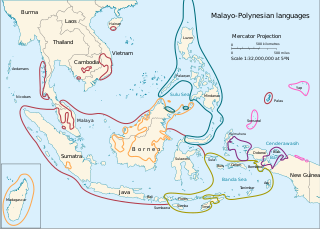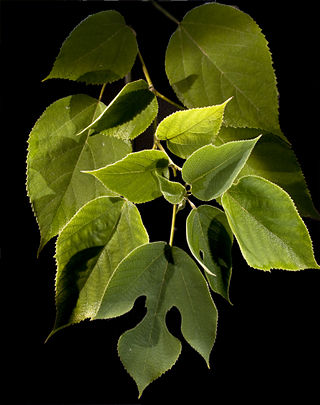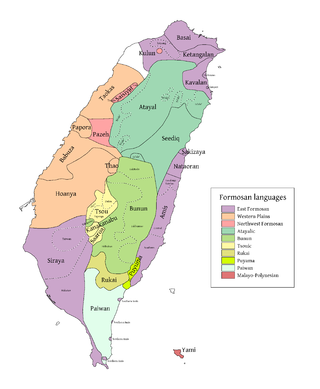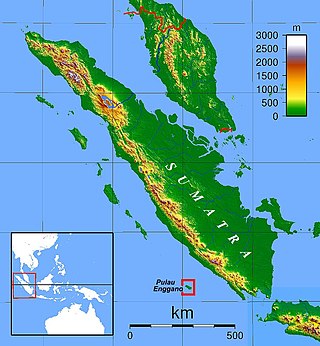Lexicon
This article or section should specify the language of its non-English content, using {{ lang }}, {{ transliteration }} for transliterated languages, and {{ IPA }} for phonetic transcriptions, with an appropriate ISO 639 code. Wikipedia's multilingual support templates may also be used.(June 2021) |
From the mid-1990s to 2023, reconstructing the lexicon of Proto-Oceanic was the object of the Oceanic Lexicon Project, run by scholars Andrew Pawley, Malcolm Ross and Meredith Osmond. [5] This encyclopedic project produced 6 volumes altogether, all available in open access.
In addition, Robert Blust also includes Proto-Oceanic in his Austronesian Comparative Dictionary (abbr. ACD). [6]
Animal names
Selected reconstructed Proto-Oceanic terms of various animals from Blust's ACD:
- Fishes
Proto-Oceanic Common name Scientific name *bubu₇ triggerfish Balistes sp. *sumu triggerfish Balistidae *sulik a fish, the fusilier Caesionidae sp. *tipi-tipi butterflyfish Chaetodon spp. *taŋapa wrasse Cheilinus spp. *bolo bolo small dark surgeonfish possibly Ctenochaetus *komi suckerfish / remora Echeneis naucrates ; hold on by biting *kamaRi a fish, the rainbow runner Elagatis bipinnulata *piRu-piRu sailfish Istiophoridae *kulabo a fish Lethrinidae spp. *sabutu; *surup₂; *susul₁; *kasika a fish, the emperor Lethrinus spp. *tasiwa sea perch Lutjanus sp. *pu-pulan a white fish, the tarpon; herring Megalops cyprinoides *tiqo goatfish family Mullidae *mwanoRe unicornfish Naso unicornis *taRa short snouted unicornfish Naso spp. *lau a fish, the banded sweetlips Plectorhinchus spp. *lio-lio brown triggerfish Pseudobalistes fuscus *kitoŋ rabbitfish Siganus punctatus (family Siganidae) *palaja rabbitfish Siganus sp. *takua yellowfin tuna Thunnus albacares *piRa₂ sailfin tang Zebrasoma veliferum
- Birds
Proto-Oceanic Common name Scientific name *pusiRa starling Aplonis spp. *kaRa male eclectus parrot Eclectus roratus *kao heron probably Egretta sp. *kiki₁ kingfisher Halcyon spp. *kikau, *kipau Bismarck scrub fowl Megapodius eremita *sau a bird, the Golden Whistler Pachycephala spp. *takere a bird, the fantail Rhipidura sp. *bune fruit dove probably Treron spp. *pwirip parrot probably Trichoglossus sp.
- Other animals
Proto-Oceanic Common name Scientific name *poñu the green turtle Chelonia mydas *kasi to scrape; scraper or grater made from circular bivalve shell Asaphis spp. *buliq₁ cowrie shell Cypraea mauritiana *sapulu bivalve mollusc possibly Pinna sp.
Plant names
Pawley and Ross (2006)
Reconstructed Proto-Oceanic terms for horticulture and food plants (other than coconuts): [7]
- Tubers and their culture
Proto-Oceanic Meaning *mwapo(q) taro (possibly all Araceae) *talo(s) taro, Colocasia esculenta *piRaq giant taro, elephant ear taro, Alocasia macrorrhiza *bulaka swamp taro, Cyrtosperma merkusii *kamwa kind of wild taro (?) *qupi greater yam, Dioscorea alata ; yam (generic) *pwatik potato yam, aerial yam, Dioscorea bulbifera *(s,j)uli(q) banana or taro sucker, slip, cutting, shoot (i.e. propagation material) *wasi(n) taro stem (used for planting) *bwaŋo new leaves or shoots, or taro tops for planting *up(e,a) taro seedling *pasoq[-i] to plant (tubers) *kotiŋ to cut off taro tops
- Bananas
Proto-Oceanic Meaning *pudi banana, Musa cultivars *joRaga banana, Australimusa group *sakup kind of cooking banana: long with white flesh (presumably Eumusa group)
- Other food plants
Proto-Oceanic Meaning *topu sugar cane, Saccharum officinarum *pijo a kind of edible wild cane or a reed, Saccharum spontaneum *[ka]timun cucurbit (generic); cucumber, Cucumis sativus *laqia ginger, Zingiber officinale *yaŋo turmeric, Curcuma longa *kuluR breadfruit, Artocarpus altilis *baReqo breadfruit fruit (?) *padran pandanus (generic); coastal pandanus, Pandanus tectorius *kiRe coastal pandanus, Pandanus tectorius *pakum Pandanus dubius *ima kind of pandanus with useful leaves *Rabia sago, Metroxylon spp., mainly Metroxylon sagu *sag(u) sago starch *qatop sago fronds, thatch *talise Java almond, Indian almond, Terminalia catappa *qipi Tahitian chestnut, Pacific chestnut, Inocarpus fagifer *[ka]ŋaRi canarium almond, Canarium spp. *molis citrus fruit or citrus-like fruit *pau(q) mango, probably Mangifera indica *wai, *waiwai mango (generic) *kapika Malay apple and rose apple, Eugenia spp. *ñonum Morinda citrifolia *tawan Pometia pinnata *wasa edible greens, Abelmoschus manihot *m(w)asoku wild cinnamon, Cinnamomum spp. *quRis Polynesian plum, hog plum, Tahitian apple, Spondias cytherea *ñatu(q) kind of tree with avocado-like fruit and hard wood, Burckella obovata *raqu(p) New Guinea walnut, Dracontomelon dao *buaq areca palm, Areca catechu
- Gardening practices
Proto-Oceanic Meaning *quma garden *tanoq soil, earth *poki to clear ground for planting *sara to dig a hole *tanum[-i] to plant
Ross (2008)
Reconstructed plant terms from Malcolm Ross (2008): [8]
- Proto-Oceanic plant terms inherited from Proto-Austronesian or Proto-Malayo-Polynesian (65 reconstructions)
Proto-Oceanic Meaning *[a]ñuliŋ Pisonia sp. *aRu a shore tree, Casuarina equisetifolia *bai-bai(t) a cycad, Cycas rumphii *[baR]baR coral tree, Erythrina variegata *bitu(ŋ) bamboo sp. *botu(ŋ) large bamboo, presumably Bambusa sp. *buaq betelnut, areca nut, palm, Areca catechu *drokol small Dillenia sp. *droRu(ŋ) Trema orientalis *guRu(n) sword grass, Imperata cylindrica *[ja]latoŋ Laportea and Dendrocnide spp. *kanawa(n) Cordia subcordata *[ka]tim(o,u)n Cucumis spp. (generic?); cucumber, Cucumis sativus *kati(p)al a palm with black wood, Caryota sp. *kayu tree or shrub: generic name for plants with woody stems and branches, probably not including palms or tree-ferns; wood, stick *kiRe coastal Pandanus sp., probably Pandanus tectorius *kulapu(R) Dillenia schlechteri *kuluR breadfruit, Artocarpus altilis *laqia ginger, Zingiber officinale (?) *m(ʷ)aso(q)u wild cinnamon, Cinnamomum sp., probably Cinnamomum xanthoneuron ; possibly also Cananga odorata *malo paper mulberry, Broussonetia papyrifera ; barkcloth, loincloth *naRa Pterocarpus indicus *ñatuq Burckella obovata *nini(q) shrub, Donax cannaeformis *nipaq Nypa fruticans *niuR coconut palm and/or fruit, Cocos nucifera *nunuk fig trees, Ficus taxon *ŋiRac Pemphis acidula *p(ʷ)atoRu a cycad, Cycas rumphii *padran coastal pandanus, Pandanus tectorius ; pandanus (generic) *pali[s,j]i generic term for grasses and other grass-like plants *(p,b)anaRo Thespesia populnea *para(k) Zingiberaceae spp. with edible rhizomes *paRu Hibiscus tiliaceus *pila(q)u Casuarina equisetifolia *pinu(q)an Macaranga spp., perhaps Macaranga involucrata *piRaq giant taro, elephant ear taro, Alocasia macrorrhizos *piRu(q) fan palm, Licuala sp. *pitaquR Calophyllum inophyllum *pudi banana, Musa cultivars *[pu-]pulu betel pepper, Piper betle *puna vine used for fish poison, probably Derris elliptica *putun Barringtonia asiatica *qa(l,R)a Ficus sp. *qaramʷaqi Pipturus argenteus *qasam fern used for tying and binding, Lygodium circinnatum *(qate-)qate Wedelia biflora *qauR bamboo spp. *qipil a taxon of hardwood trees including Intsia bijuga and Casuarina equisetifolia *qu(w)e rattan, Calamus spp. *qupi greater yam, Dioscorea alata : yam (generic) *Rabia sago, Metroxylon spp., mainly Metroxylon sagu (syn. Metroxylon rumphii ) *raqu(p) New Guinea walnut, Dracontomelon dao *rarap coral tree, Erythrina spp. *talise Terminalia catappa *talo(s) taro, Colocasia esculenta *toŋoR mangrove, Bruguiera spp.; mangroves (generic) *topu sugarcane, Saccharum officinarum *toRas a taxon of hardwood trees including Intsia bijuga (?) *tui Dolichandrone spathacea *tupa climbing shrubs, Derris spp. *wai, *waiwai mango (generic) *walasi tree sp. with poisonous sap, Semecarpus forstenii *waR[e] Flagellaria indica *waRoc generic term for vines and creepers, plants with creeping or climbing growth structure; string, rope
- Proto-Oceanic plant terms inherited from Proto-Central-Eastern Malayo-Polynesian (11 reconstructions)
Proto-Oceanic Meaning *[bual]bual species of palm used for making spears and bows; palm-wood spear or bow, probably Caryota sp. *dalo Calophyllum inophyllum *dradrap Hoya sp. *ima Pandanus sp. with useful leaves *jasi Cordia subcordata *kai(k) Albizia sp. *[ka]ŋaRi canarium almond, Canarium indicum *lowaŋa Litsea sp. *pail Falcataria moluccana *pau(q) mango, Mangifera sp. (not Mangifera indica ) *Reqi sword grass, Imperata cylindrica
- Proto-Oceanic plant terms inherited from Proto-Eastern Malayo-Polynesian (4 reconstructions)
Proto-Oceanic Meaning *na[su]-nasu Scaevola taccada *qayawan Ficus , strangler fig taxon *tawan [9] Pometia pinnata *tuRi-tuRi candlenut tree, Aleurites moluccanus (?)
- Reconstructed terms with no external cognates
- Proto-Oceanic plant terms with no known non-Oceanic cognates (97 reconstructions)
Proto-Oceanic Meaning *ba(k,g)a banyan tree, medium-sized Ficus spp., not stranglers *babak Falcataria moluccana *bala taxon including various Euodia spp. (?) *baqun banana cultivar *baReko breadfruit *bau hardwood taxon *bele Abelmoschus manihot *beta breadfruit *biRi-biRi Hernandia nymphaefolia *bosi a forest tree with white wood, probably Euodia elleryana *bou Fagraea spp. *bulu Garcinia sp., perhaps Garcinia novo-guineensis *b(ʷ)ala tree fern, Cycas or Cyathea sp. *bʷau bamboo *bʷele bamboo sp. *bʷera Musa cultivar *drala shrub sp., Vitex trifolia *(dr,d)aRa(q,k)a wild nutmeg, Myristica sp. *i(u)bu Corynocarpus cribbianus *iguRa Ficus sp. with sandpapery leaves, either Ficus copiosa or Ficus wassa or both *ipi Tahitian chestnut, Inocarpus fagifer *jajal croton, Codiaeum variegatum *jamaR Commersonia bartramia *jiRi taxon consisting of Cordyline fruticosa and Dracaena angustifolia *joRaga banana, Fei (?) cultivars *ka(mʷa)-kamʷa Ficus sp., perhaps Ficus nodosa *ka[(r,l)a]qabusi Acalypha spp. *kalaka Planchonella sp. *kapika Malay apple, rose apple, Syzygium malaccense *karagʷam seaweed, seagrass *kaRi(q)a taxon of decorative plants *kaRi(q)ana Pandanus lamekotensis *kayu qone Heritiera littoralis *koka Macaranga spp. *koma(r,R)(o,u) Endospermum sp. *kopu bamboo sp. *koRa wild mango, Mangifera minor *kurat the dye produced from Morinda citrifolia *m(ʷ)ase wild mulberry, paper mulberry, Broussonetia papyrifera *ma(i)tagaR(a) Kleinhovia hospita *mapuqan Flueggea flexuosa (?) *maqota Dysoxylum spp. *maRakita the putty nut, probably Parinari laurina and Parinari glaberrima *maRako Trichospermum peekelii *mari(a)sapa Syzygium sp. *molis citrus fruit or citrus-like fruit, perhaps Clymenia polyandra *mʷala(q)u Glochidion philippicum *mʷalak (?) spider lily, Crinum asiaticum *mʷaña Pandanus sp., perhaps Pandanus conoideus *mʷapo(q) taro, Colocasia esculenta *mʷaruqe Dioscorea sp. or perhaps a cultivar of Dioscorea alata *nipus Cryptocarya sp. *ñoñu Morinda citrifolia *olaŋa Campnosperma brevipetiolatum *pakum Pandanus dubius *pala(ŋ) cut nut, bush nut, Barringtonia novae-hiberniae (green variety?) *paliaRua a vine, Merremia peltata *paqo Heliconia sp. *paqu Kleinhovia hospita *pasa(r,R) Vitex cofassus *pesi a coastal forest tree, perhaps Pongamia pinnata *pi(y)uŋ Miscanthus floridulus *pijo cane or reed taxon, including Saccharum spontaneum *poipoi Pandanus sp., perhaps Pandanus tectorius *poka(q) variety of Malay apple *(p,b)oso kind of taro *puRe taxon of beach creepers; perhaps prototypically Ipomoea grandiflora and Ipomoea pes-caprae *pʷa(k,g)e kind of green vegetable (?) *pʷabosi free-standing small or medium-sized Ficus sp., probably Ficus wassa *p(ʷ)asa(r,R) large Pandanus sp. *pʷatika potato yam, aerial yam, Dioscorea bulbifera *p(ʷ)awa(t) Cerbera spp., probably Cerbera floribunda and Cerbera manghas *pʷete bird's nest fern, Asplenium nidus *pʷi(r,R)a Cananga odorata *qarop Premna spp. *qat(V) Terminalia sp. with edible nut *(q,k)atita the putty nut, probably Parinari laurina and Parinari glaberrima *(q)alipa, *lalipa nut sp., possibly canarium almond, Canarium sp. (?) *qope Gyrocarpus americanus *quRis Spondias cytherea *(quta)quta grass and weeds (generic) *rabum grass *Rigi rosewood, Pterocarpus indicus *sabakap Alstonia scholaris *sakup banana cultivar with long fruit (?) *seRa Ficus sp., perhaps Ficus adenosperma *sila Job's tears, Coix lacryma-jobi *tamanu Calophyllum sp. *taŋa Ficus tinctoria *tapi(l) puzzlenut tree, Xylocarpus granatum (?) *tapoRa a nut-bearing tree sp. *tawasi Rhus taitensis *toRu Cordia subcordata *udu(r,R) Dioscorea alata cultivar (?) *wasa Abelmoschus manihot ; green vegetables in general *wasi-wasi Abroma augusta *yaŋo turmeric, Curcuma longa
- Proto-Western Oceanic plant terms with no known external cognates (22 reconstructions)
Proto-Oceanic Meaning *bara Macaranga spp. *basi mango *baul mangrove, Rhizophora sp. (?) *bʷana Intsia bijuga *bʷatiq banana cultivar *gobu Dioscorea sp. *ka(p)ul seed yam *kamisa lesser yam, Dioscorea esculenta *kam(ʷ)apaR Cryptocarya sp. *kasuwai mango *kobo taxon of Macaranga spp. *kokoi mushroom sp. *[ku,i]Rim(a,o) Octomeles sumatrana *lapuka kind of tree with fruit similar to breadfruit, Parartocarpus venenosa (?) *m(ʷ)ali Derris sp. *mamisa lesser yam, Dioscorea esculenta *moke Pandanus sp. *mʷa(r,R)e taxon including Codiaeum variegatum and Cordyline fruticosa *nagi Cordia sp. *(s,j)a(q,k)umu Pandanus sp. *tabun Garcinia sp. *tabuqaR Saccharum edule
- Proto-Eastern Oceanic plant terms with no known external cognates (15 reconstructions)
Proto-Oceanic Meaning *bakuRa Calophyllum sp., probably Calophyllum kajewskii *buka taxon of littoral trees, including Pisonia spp. and Gyrocarpus americanus *bulipa Ficus sp. *gama Finschia cloroxantha *(k)a(r,l)adroŋa Acalypha sp. *koka tree sp., Bischofia javanica *mabʷe Tahitian chestnut, Inocarpus fagifer *melo Elaeocarpus angustifolius *milo Thespesia populnea *mʷa(q)ele a cycad, Cycas rumphii *pakalo, *pʷakala (?) Hibiscus sp. *paRage Pangium edule *pinuaq a nut tree, perhaps Canarium sp. (?) *rako Heliconia sp., usually Heliconia indica *sinu taxon of shrubs whose sap causes irritation, including species of Phaleria
- Proto-Remote Oceanic plant terms with no known external cognates (6 reconstructions)
Proto-Oceanic Meaning *buavu Hernandia sp. *maRi breadfruit *sasaRu Abelmoschus manihot *vaRo Neisosperma oppositifolium *vuba kind of vine, probably Derris elliptica *wasi-wasi Sterculia vitiensis
Blust and Trussel (2020)
Selected reconstructed Proto-Oceanic terms of various plants from the Austronesian Comparative Dictionary: [6]
Proto-Oceanic Common name Scientific name *kalaqabusi a shrub Acalypha sp. *piRaq₂ wild taro, elephant-ear or itching taro Alocasia spp. *sabakap a tree Alstonia scholaris *putun₁ a shore tree Barringtonia spp. *que rattan Calamus sp. *pitaquR a shore tree Calophyllum inophyllum *kaŋaRi tree with edible nut, the Canarium almond Canarium commune *(q)alipa a nut tree Canarium sp. *aRu a shore tree Casuarina equisetifolia *talos taro Colocasia esculenta *toRu a tree Cordia subcordata *aŋo turmeric Curcuma longa *punat a plant used to stun fish Derris elliptica *tupa₂ fish poison Derris spp. *pwatika potato yam, aerial yam Dioscorea bulbifera *rarap a tree with dense clusters of red flowers, the Indian coral tree Erythrina indica *buRat a tree with sweet-smelling flowers Fagraea berteroana *pail a plant Falcataria moluccana *taŋa₃ a shrub with edible figs Ficus tinctoria *baka₂ kind of banyan tree Ficus sp. *pwano-pwano a plant Guettarda speciosa *paqo a plant Heliconia spp. *kuRun; *pitu₂ sword grass Imperata cylindrica *ipi₂ the ‘Tahitian chestnut’ Inocarpus fagiferus or Inocarpus edulis *puRe₂ beach creepers including Ipomoea grandiflora and Ipomoea pes-caprae *pau a plant Kleinhovia hospita *karat₂ a small stinging plant perhaps Laportea interrupta *latoŋ, *la-latoŋ, *salatoŋ, *silatoŋ stinging nettle Laportea spp. *piRu fan palm Licuala rumphii *pinuan a tree Macaranga spp. *koka a tree Macaranga spp., Euphorbiaceae *koRa wild mango Mangifera minor *paliaRua a vine Merremia peltata *gurat a tree with roots that furnish a red dye Morinda citrifolia tree *kurat the dye produced from the Morinda citrifolia Morinda citrifolia dye *ñoñu tree with inedible white fruit and root that yields a useful dye Morinda citrifolia tree *paoq (ʔ) a tree Ochrosia oppositifolia *mwaña pandanus sp. probably Pandanus conoideus *kiRe a pandanus Pandanus odoratissimus ; a mat made from the leaves of this plant *katita putty nut Parinari laurinum *pu-pulu betel pepper Piper betle *pesi coastal tree perhaps Pongamia pinnata *tawasi a tree Rhus taitensis *pijo kind of reed or cane including Saccharum spontaneum *kapika, *kapiku the Malay apple Syzygium malaccense *talise₁ a shore tree with edible nuts Terminalia catappa *pasa(r,R) a woody plant or tree Vitex cofassus








